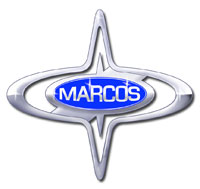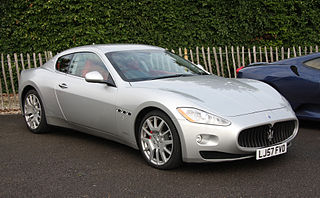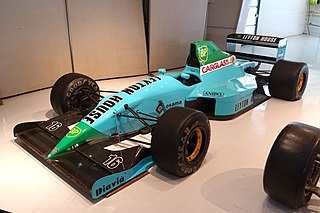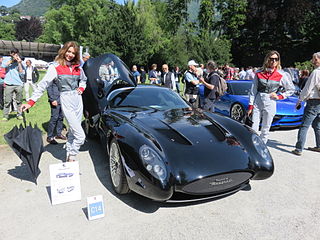
Marcos Engineering was a British sports car manufacturer. The name derives from the surnames of founders Jem Marsh and Frank Costin.

The Koenigsegg CC8S is a mid-engine sports car produced by the Swedish automobile manufacturer Koenigsegg. It was the company's first production automobile and the first production car to use the company's trademark dihedral synchro-helix actuation doors. At its introduction, it won several awards, including the Guinness World Record for the Most Powerful Production Engine and design awards from both Red Dot in Germany and Utmärkt Svensk Form in Sweden.

The Aston Martin DB7 is a car which was produced by British luxury car manufacturer Aston Martin from September 1994 to December 2004. It was designed by Ian Callum and Keith Helfet as a grand tourer in coupé and convertible bodystyles. The prototype was complete by November 1992 and debuted at the Geneva Motor Show in March 1993. The six-cylinder DB7 was positioned as an "entry-level" model below the hand-built V8 Virage introduced a few years earlier. This model was the most-produced Aston Martin automobile up to that point in time, with more than 7,000 built before it was replaced by the DB9 in 2004.

The Ferrari Mondial is a mid-engined, V8, grand tourer manufactured and marketed by Ferrari between 1980 and 1993 – with styling by Pininfarina and bodywork by Carrozzeria Scaglietti.

The Aston Martin Vantage is a series of hand-built sports cars from the British automotive manufacturer Aston Martin. Aston Martin has previously used the "Vantage" name on high-performance variants of their existing GT models, notably on the Virage-based car of the 1990s. The modern car, in contrast, is the leanest and most agile car in Aston's lineup. As such, it is intended as a more focused model to reach out to potential buyers of cars such as the Porsche 911 as well as the exotic sports and GT cars with which Aston Martins traditionally compete.

The Morgan Aero 8 sports car was built by Morgan Motor Company at its factory in Malvern Link, England from 2000 until 2018.

The Koenigsegg CCX is a mid-engine sports car manufactured by Swedish automotive manufacturer Koenigsegg Automotive AB. The project began with the aim of making a global car, designed and engineered to comply with global safety and environment regulations, particularly to enter the United States car market. To sell cars in the US, many alterations were made to the design of the CCR; the previously used Ford Modular engine was replaced by an in-house developed Koenigsegg engine designed to run on 91 octane fuel, readily available in the United States, and to meet Californian emission standards.

The Aston Martin DBS is a high-performance grand tourer based on the DB9 and manufactured by the British luxury automobile manufacturer Aston Martin.

The Daimler SP250 is a sports car built by the Daimler Company, a British manufacturer in Coventry, from 1959 to 1964. It was the last car to be launched by Daimler before its parent company, the Birmingham Small Arms Company (BSA), sold it to Jaguar Cars in 1960.
Sylva Autokits is a kit car manufacturer based in Lincolnshire, England. Sylva was founded in 1981 by Jeremy Phillips and has developed and produced a number of small and lightweight sports cars. Sylva cars have won a number of 750 Motor Club Kit Car championships.

The Maserati GranTurismo and GranCabrio are a series of a grand tourers produced by the Italian automobile manufacturer Maserati. They succeeded the two-door V8 grand tourers offered by the company, the Maserati Coupé and Spyder.

The Leyton House CG901 was a Formula One racing car designed by Adrian Newey for the 1990 Formula One World Championship. Five chassis were built and were powered by the Judd EV 3.5 litre V8 engine. Chassis 001 was subsequently modified mid-season to accommodate the Ilmor 2175A engine the team used in 1991. The drivers for 1990 were the highly rated Ivan Capelli and Maurício Gugelmin. The CG in the name stood for Cesare Gariboldi, a March Leyton team manager who was killed in a road accident in 1989.

The Lotus Evora is a sports car produced by British car manufacturer Lotus. The car, which was developed under the project name Project Eagle, was launched on 22 July 2008 at the British International Motor Show. The Evora S was launched in 2010 with a supercharged 3.5-litre V6. A facelifted and more powerful Evora 400 model was unveiled at the 2015 Geneva Motor Show, followed by another more powerful variant, the Evora GT430, which was unveiled in 2017.
The Lotus Esprit GT1 was a sports racing car produced by Lotus Engineering, a subsidiary of Lotus Cars formed to develop racing cars to compete in the GT1 class racing. It competed in the BPR Global GT Series in the mid-1990s.

The Jaguar XJ (X350) is a full-size four-door luxury saloon car manufactured and marketed worldwide by Jaguar Cars for model years 2003–2009 as the third generation of the Jaguar XJ saloon, carrying the internal designation X350 and the internal designation X358 following its 2007 intermediate facelift. Both the X350 and X358 were available with a six-speed automatic transmission, a range of petrol and diesel engines, numerous trim levels, and short wheelbase (2003–2009) or long wheelbase (2005–2009) car body configurations. Extended-length models were the longest vehicles Jaguar had manufactured.

The Jaguar XK is the second and final generation of the Jaguar XK 2+2 grand tourer manufactured and marketed by British automobile manufacturer Jaguar Cars under the X150 internal designation. The three-door fastback coupé debuted at the 2005 Frankfurt Motor Show with the 4.2-litre V8 engine of its predecessor, and the two-door convertible debuted in 2006 at the North American International Auto Show.

The Jaguar XK8 is a grand tourer launched by Jaguar Cars in 1996, and was the first generation of a new XK series. The XK8 was available in two-door coupé or two-door convertible body styles with the new 4.0-litre Jaguar AJ-V8 engine. In 1998, the XKR was introduced with a supercharged version of the engine. In 2003, the engines were replaced by the new 4.2-litre AJ34 engines in both the naturally aspirated and supercharged variations. The first-generation of the XK series shares its XJS-derived platform with the Aston Martin DB7, with both cars tracing their history back to an abandoned Jaguar development study in the mid-1980s known as XJ41/XJ42, which had been mooted to be known as the F-Type.

The Jaguar XE (X760) is a car manufactured by Jaguar Land Rover and marketed under their Jaguar marque since April 2015. A large family car, it has a four-door saloon car body style and is aimed at the compact-executive market segment. It is front engined and sold with both rear-wheel drive and all-wheel drive. The successor to the X-Type, it was designed by Ian Callum and launched at the October 2014 Paris Motor Show.

The McLaren 650S is a British sports car designed and manufactured by British automobile manufacturer McLaren Automotive. It was announced in February 2014 as a new model, but based on the existing MP4-12C with 25% new parts, and was formally unveiled at the 2014 Geneva Motor Show.

The Zagato Maserati Mostro is a limited edition car, produced by Zagato and revealed at the 2015 Villa d'Este Concours d'Elegance.




















